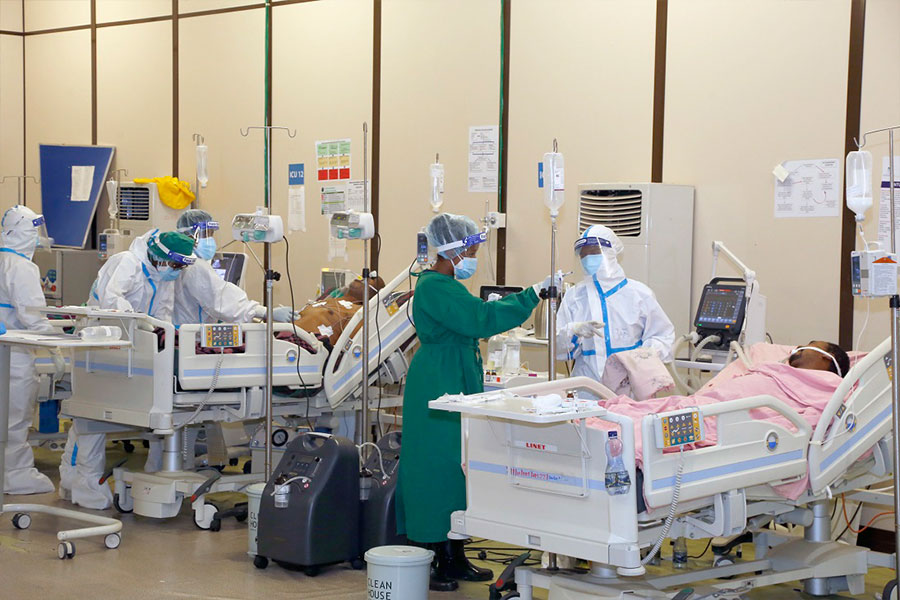
Sunday with Eden | Jan 16,2021
Jun 1 , 2019
By Mathias Nigatu Bimir
Ethiopia is among the largest economies in developing Africa and one of the fastest growing in the past two decades. Since the 1991 regime change, the country followed a policy direction known as Agricultural Development Led Industrialization (ADLI) with the intention of advancing industrial output backed by agriculture.
Its economy has experienced rapid growth in the past two decades averaging about 10.3pc in the period from 2005/2006 to 2015/2016. That is higher than the regional average of 5.4pc.
Yet the fact that its merchandise imports overwhelmingly exceed its exports, resulting in a large deficit, is a headache for the country’s policy makers. There is a need for structural transformation. Most of the country’s products remain in the primary sector and stem from low-value manufacturing so far.
Dawdling industrialisation in Ethiopia is linked to the nature of the products that the country is used to producing for a long period of time. The Product Space framework, a methodology economists use, can best explain a country’s industrial diversification and potential to gain a comparative advantage.
In this framework, products that provide more extensive diversification opportunities for new items are placed in the core of the space, while the periphery has products that require know-how that is less relevant for many new products. It represents the proximity between products traded in the global market, categorising them into clusters based on their connection in the network. In this regard, industrial policy also plays a significant role in the growing world market competition and the global value chains that demand better domestic competitiveness of traded goods.
During the early 1990s, the products in the export basket of Ethiopia were few, such as coffee beans, oil seeds, legumes, raw cotton, hide and skins, etc., all at the periphery of the Atlas Economic Complexity, a visualisation tool used to understand these trade dynamics. This revealed a comparative advantage score of less than one. Coffee was the most traded commodity Ethiopia had, while other raw products were sparsely produced, and the economic complexity rank at that time was 122 out of 127 countries.
Since the 1990s, Ethiopia has undergone some transformation in the production of goods and this is reflected not only in the growth in the number of products but also in the demonstrated comparative advantage. Many of the raw products previously in the export basket were transformed later and new products emerged especially in the first two decades of the 20th century. The top exports in the early 2000s include roasted and coffee powder, oilseeds, gold, dried legumes, cut flowers, garments, footwear and other leather items. When compared with 1992, the change in industrial structure is slightly improved, with 46 of the 56 products having a comparative advantage score of more than one in the primary sector, according to the World Bank.
The improvement in the comparative advantage of those products, however, was not necessarily due to the improvements made but the aggressive export promotion job that was done by the government. All consular offices were pushed to market Ethiopian export products aggressively.
The ubiquitous nature of most of the products (coffee is produced in many countries) and the low-level knowledge they require made it difficult to win comparative advantage easily. At this level, only two products, organic chemicals and power generating machines, reached to sectors that are thought to be sophisticated in the Product Space framework.
The latest data in 2016 the economic complexity ranking shows Ethiopia at 110th place among all countries, and it is still far from the center in the product space. Coffee, legumes, cut flowers and oilseeds dominate the export basket. Agricultural products, i.e. coffee, sesame and vegetables, together account for more than 50pc of total goods exported in 2011–14.
More products were added in the leather and textile domain however. Now the country is producing finished bags, women’s coats and jackets, footwear, undergarments, shirts, suits, etc. Product variety increased mostly in textiles, agro-processing and other mineral products. The textile and garment sector still lacks the latest technologies to produce internationally competitive products even though there is an abundance of raw materials.
Diversified industrialisation processes are a challenge for many countries like Ethiopia due to the nature of products they are able to produce with existing capabilities. The formulation of sound industrial policy by itself doesn’t guarantee industrial diversification. Rather, the existing ability of the country to diversify and move into more complex products heavily depends on its initial location in the product space, which shows the societal level of product knowledge.
By this measure, Ethiopian products are placed at the periphery, since they do require un/semi-skilled labour and possess limited diversification opportunities.
The latest promising development in Ethiopia that can take it to a potentially higher level on the complexity product space are the budding vehicle assembly operations. The government-owned Metals & Engineering Corporation, in partnership with a Chinese supplier, has successfully assembled buses and light vehicles for domestic transport in the past few years. The South Korean manufacturing giant Hyundai has started assembling cars in the country. Volkswagen also has signed an agreement in 2019 to enter into car production.
This presents good opportunities for domestic firms to learn new skills in manufacturing. If properly dealt with, the transfer of know-how, the import substitution and even the potential for export to neighboring countries can bring huge benefits. This can best be utilized by existing firms mainly in steel and electrical products processing.
The country should pay due consideration to the trade-off between the density of exports and sophistication, focusing more on the complexity than the mere increment in the number of peripheral products. Meanwhile, there is one challenge to the future of the manufacturing industry, a high tendency of firms shifting their capital to the service sector.
The reason could be the higher distance of high-value products with existing capability. The booms in the construction industry, especially since 2005, can be seen as an example with the exponential growth of contractors. The same applies to medical, financial, education and hotel services.
Currently, the service sector significantly outweighs manufacturing. Of these, only the transport and tourism sub-sectors have noteworthy export earnings. As a result, the trade imbalance is increasing with declining exports. This requires reorienting industrial policy.
In general, the industrial outputs of Ethiopia are still at a distance from the high-value products. Domestic firms need to improve their capabilities in researching proximate products through perpetual trials in which inter-firm learning can play a great role.
In order to revive the manufacturing sector, the industrial policy also needs to identify new product development possibilities that can have increased comparative advantage incrementally and incentivise firms keen in the production of more complex products through long-term trial and error.
It also needs to review the research and development sector to make it a catalyst for new product development in the export sector. The country has been investing a huge sum of money on higher education in the past twenty years, establishing over 35 universities with the hope of more research output. But these universities have played only a marginal research and development role for industry. They require interventions including downsizing enrollment and shifting the budget to selected technical research areas.
Mathias Nigatu Bimir is a public policy doctoral student at Hong Kong University of Science and Technology. He has served as a faculty member at Kotebe Metropolitan and Arba Minch universities. He can be reached at mnbimir@connect.ust.hk
PUBLISHED ON
Jun 01,2019 [ VOL
20 , NO
996]


Sunday with Eden | Jan 16,2021

Radar | Aug 08,2020

Agenda | Apr 03,2021

Fortune News | Apr 13,2019

Radar | Nov 30,2019

Fortune News | Oct 23,2018

Commentaries | Dec 28,2019

Commentaries | Feb 27,2021

Viewpoints | May 24,2025

Radar | Jun 15,2025

Photo Gallery | 174797 Views | May 06,2019

Photo Gallery | 165019 Views | Apr 26,2019

Photo Gallery | 155270 Views | Oct 06,2021

My Opinion | 136727 Views | Aug 14,2021

Dec 22 , 2024 . By TIZITA SHEWAFERAW
Charged with transforming colossal state-owned enterprises into modern and competitiv...

Aug 18 , 2024 . By AKSAH ITALO
Although predictable Yonas Zerihun's job in the ride-hailing service is not immune to...

Jul 28 , 2024 . By TIZITA SHEWAFERAW
Unhabitual, perhaps too many, Samuel Gebreyohannes, 38, used to occasionally enjoy a couple of beers at breakfast. However, he recently swit...

Jul 13 , 2024 . By AKSAH ITALO
Investors who rely on tractors, trucks, and field vehicles for commuting, transporting commodities, and f...

Oct 18 , 2025
The political establishment, notably the ruling party and its top brass, has become p...

Oct 11 , 2025
Ladislas Farago, a roving Associated Press (AP) correspondent, arrived in Ethiopia in...

Oct 4 , 2025
Eyob Tekalegn (PhD) had been in the Governor's chair for only weeks when, on Septembe...

Sep 27 , 2025
Four years into an experiment with “shock therapy” in education, the national moo...

Oct 18 , 2025 . By NAHOM AYELE
In a sweeping reform that upends nearly a decade of uniform health insurance contribu...

Oct 18 , 2025 . By BEZAWIT HULUAGER
A bill that could transform the nutritional state sits in a limbo, even as the countr...

Oct 18 , 2025 . By SURAFEL MULUGETA
A long-planned directive to curb carbon emissions from fossil-fuel-powered vehicles h...

Oct 18 , 2025 . By BEZAWIT HULUAGER
Transaction advisors working with companies that hold over a quarter of a billion Bir...